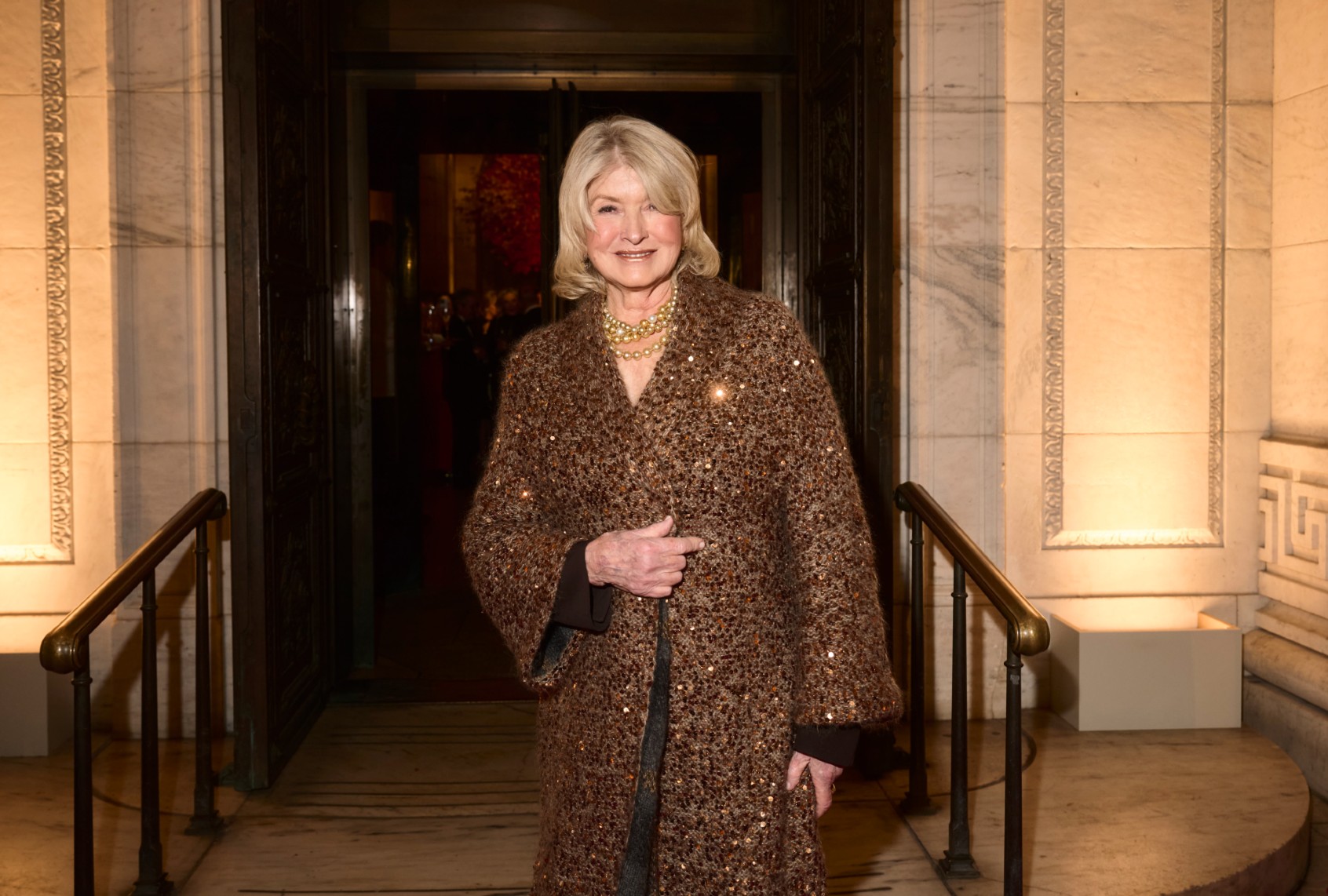“She’s kind of been a staple in our house as long as I can remember. My mom always had her playing in the background growing up, as a kid. So, yeah. I’m a big fan. And I remember, I watched her documentary recently, and I tried searching for her book ‘Entertaining.’ And it skyrocketed in price. So I’m really happy that she’s reissuing it and I can finally get my hands on it. So let’s go check it out, see if they have it.”
This semi-breathless commentary comes via a TikTok video from a creator named Noah, who has parked in front of a Barnes & Noble, and the subject of his excitement is Martha Stewart — specifically, her 1982 book “Entertaining,” published when she was still a sought-after caterer. Both cook- and coffee-table book, “Entertaining” was a publishing anomaly, if not exactly a sensation. At a time when cookbooks from even big names like Julia Child and Madhur Jaffrey were printed in black and white, “Entertaining” was big and showy and cost a hefty $35, heralding the arrival of a decade defined by wealth and excess.
Stewart isn’t quite ready to pass the kitchen torch to some social-media upstart.
Stewart was inescapable in the book’s 300 recipes, 450 photos, and detailed menus and table settings for events that even in 1982 seemed lavish: a Hawaiian luau for 20, a midnight omelette party for 30. She’s on its cover, setting a table with Limoges plates and poppy-filled vases; she’s in the kitchen, framed by thousands of dollars’ worth of copper cookware; she’s in what I assume is the butler’s pantry, monitoring party prep. “Entertaining” was the first of 100-plus books Stewart would write, on topics that included cleaning, gardening, needlecrafts, children’s parties and more. But after R.J. Cutler’s 2024 documentary “Martha” hit Netflix, “Entertaining” began an unexpected afterlife as a thrift-shop Holy Grail; and Stewart, at 84 as media-savvy as ever, saw an opportunity. The reissued “Entertaining” is nearly indistinguishable from its earlier incarnation: There’s no updated introduction and no new photos. That omelette party is still for 30 whole people. Even the dedication (to her ex-husband, Andy) remains.

(Jeff Schear/Getty Images for NYCWFF) An Evening with Martha Stewart during the Food Network New York City Wine & Food Festival on October 14, 2025 in New York City.
Noah’s back in the car. “I accidentally deleted the video of me inside the store. But I got it!” he sings, brandishing the book. Turning it toward the camera, he leafs through the pages, bright-eyed. “There is quite literally every single recipe imaginable inside this book. So I’m really excited. Like, it’s actually insane.”
Gen Z’s enthusiasm for a book published two decades before many of them were born might seem curious: Cookbooks and lifestyle manuals for practically every taste abound, and young chefs make their names on social media as much as in restaurants. At least one twentysomething, Wishbone Kitchen’s Meredith Hayden, has been anointed “Gen Z’s Martha Stewart.” But Stewart isn’t quite ready to pass the kitchen torch to some social-media upstart: She’s still here and she’s still got our attention.
Martha is iconic
Though everything about her screams “New England,” Stewart grew up working-class in New Jersey, which shaped a vision of fine living that was, in theory, for everyone. Martha Stewart Living, her media empire’s flagship, was a tough sell to publishing companies in 1990: It wasn’t a high-design shelter glossy like Elle Decor or a housewife-targeted compendium like Ladies Home Journal, and thus didn’t fit into the existing magazine categories. For a long time, no one but Martha saw an audience for a mix of style, expertise and DIY projects. The key was Stewart herself, selling a way of life — of mismatched thrift-shop china plates, maximalist tablescapes, paint colors inspired by the cool blue of an Araucana chicken egg and more — that was simultaneously grandiose and subtle, rarefied and down to earth.
For Gen Z, Stewart doesn’t evoke that kind of I’m-not-enoughness. At a time when “aesthetic” is an adjective and good design is at everyone’s fingertips, she is neither an outlier nor a rival; the Gen Z introduction to her was more likely to have come by way of Comedy Central’s Roast of Justin Bieber than from a multipage “Thanksgiving from Scratch.”
Stewart is regularly credited with being the first influencer, and recognizing that she was both brand and product enabled her to see the potential of the internet far earlier than her publishing contemporaries; Martha Stewart Omnimedia, which launched in 1997, was ahead of the curve in what would become content creation. Stewart’s empire bridged the then-vast gap between upscale style and mass consumption, licensing her name to inexpensive but well-made goods (and, in a move that scandalized the upper crust and got Stewart kicked out of her country club, choosing K-Mart as her launch pad). She was unmistakably aspirational, but just as determined to show audiences that you didn’t have to be rich to live a little snooty.
Stewart wasn’t what people wanted her to be, and certainly wasn’t what people wanted women to be. She was neither warm nor self-sacrificing; she did not nurture in the expected way (mothering, she explained, was “not at all natural” for her). Stewart didn’t excel at what she did because she was a woman; rather, she took “women’s work” and poured every bit of her perfectionism and drive into it.
Martha is goals
A backlash to the feminist movement would have happened with or without Stewart, but through no fault of her own, she got stuck in an ugly one. Media turned savagely on women in the 1980s, and Stewart’s ever-expanding presence as a domestic goddess offered something a feminist-hostile culture could leverage to try and get women back to the kitchen. In fact, Stewart was already everything antifeminists despised — incredibly ambitious, not motherly in the least, and unsolicitous of men’s attention — but because that didn’t come out until much later, she was easy to caricature as a professional fussbudget smugly pointing out other women’s domestic shortcomings. Martha’s house was spotless. Martha made macaroni and cheese from scratch. Martha whipped up a darling centerpiece from pine cones, leaves, and felt. The irony made clear in “Martha” is that hyperdomesticity was one of few realms in which Stewart could be her high-maintenance, Type-A, meticulous and perfectionist self, and it came at the expense of family harmony. She didn’t make the work look easy, but she did make it look worth the effort.
We need your help to stay independent
For Gen Z, Stewart doesn’t evoke that kind of I’m-not-enoughness. At a time when “aesthetic” is an adjective and good design is at everyone’s fingertips, she is neither an outlier nor a rival; the Gen Z introduction to her was more likely to have come by way of Comedy Central’s Roast of Justin Bieber than from a multipage “Thanksgiving from Scratch” how-to. The beauty hacks Stewart dispenses on socials don’t come from the same place as a reminder to clean the baseboards in your house yearly. The Martha these young women look up to is aspirational, but not prescriptive. Or, as she put it when asked why she thinks “Entertaining” is relevant to a younger generation, “I’m cool. Not only can I cook, I hang out with Snoop Dogg and I’ve gone to jail. I have been through the wringer and come out alive.” (And if anyone needs to know the correct spelling and definition of “wringer,” she’s your woman.)

(Valerie Terranova/Getty Images) Martha Stewart attends the 2025 Library Lions gala at New York Public Library on November 03, 2025 in New York City.
Martha is neurospicy
The famously chilly, terrifyingly fastidious Stewart never had a great reputation as an employer; she was always in control and on watch. Stories of would-be lifestyle mavens who failed to reach her exacting standards were shared in disbelieving tones; I still think about the woman I once met whose job in Martha Stewart Living’s test kitchen involved sorting through hundreds of freshly baked cookies and brownies to find the one or two that might pass muster. Stewart built her brand on making things look beautiful and taste delicious — but even more on order, scheduling, and perfection: Each issue of the magazine included “Martha’s Calendar,” whose days listed a rigorous schedule of home and garden tasks (“prune tropical plants”), animal care (“give donkeys their summer haircuts”) and work engagements. If there’s one famous woman who has been called a bit*h more than Hillary Clinton, it’s Stewart.
Gen Z, unlike those before them, does not consider any of this a problem. On the contrary: There’s a corner of social media that has welcomed Stewart with its secret handshake: an armchair diagnosis of autism. In watching Netflix’s “Martha” — in which Stewart sits, not particularly comfortably, for an on-camera interview — neurodivergent viewers recognized themselves in her prickliest behaviors. “Perfectionist is old-timey for neurodivergent,” asserted one commenter. Another mentions a video in which Stewart describes her many farm birds with a lengthy taxonomy of species and provenance, adding, “It was definitely giving special interest.”
Start your day with essential news from Salon.
Sign up for our free morning newsletter, Crash Course.
Stewart’s need to be in control and focus on her salad does not faze them. They clock her flat affect and her aura of inflexible certainty; they feel seen by the idiosyncrasies and mannerisms that others find off-putting. “She’s an avoidantly attached tism queen and that’s relatable AF for me fam” was one effusive reaction to the film. Stewart’s autism-coded traits had alreeady been noted by media and disability scholars of an earlier vintage (one academic paper on the subject is titled “Detail and Abstraction: Martha Stewart, Autism, and Utopian Narrative”); as far as Gen Z is concerned, Neurodivergent Martha is canon. There’s no word on whether or not Stewart agrees, but it’s safe to assume she couldn’t care less.
Martha is a vibe
The reissue of “Entertaining” has landed in the midst of some heated debate about another aesthetic currently sweeping social Gen Z: a so-called Ralph Lauren Christmas, whose components (fir-tree garlands, velvet bows, tartan wrapping paper and monogrammed napkins) have Gen Z shoppers scrambling to capture the look. Ralph Lauren Christmas, in truth, has been the template for regular Christmas until very recently, the aspirational benchmark set by “Home Alone” and “The Family Stone” and untold numbers of Hallmark Channel holiday offerings. The speed with which social media rediscovers and updates and reboots trends makes the classic spread — or, as a few TikTok denizens have sniffed, the extremely basic spread — seem unsettlingly meta. But for this year, “Entertaining” will fold into Gen Z’s ideal ambiance like it’s always been there. Who knows, it might even inspire a few midnight omelette parties.
Read more
about domestic aesthetics


